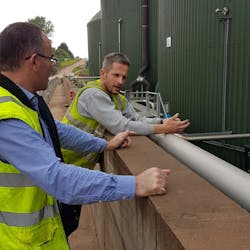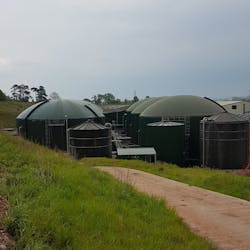Cannington Bio Energy Installs Landia Pump to Work in Conjunction with Degritter
A decade since it began, Cannington Bio Energy’s hive of activity is impressive — with volumes of waste arriving, waste being treated — and green energy being produced. If only it was as simple as all that.
In the demanding waste-to-energy industry, the Cannington site in Somerset is a place where improvements through careful fine-tuning never stop — never afraid to meet the challenges of producing biogas head-on. The contents of thousands upon thousands of food waste caddy bags are not a pretty sight, and they certainly don’t smell of roses, but this is a center of excellence with a refreshing and very down to earth balance of science and common sense that the AD industry can learn a great deal from. From the unfortunate avalanche of unwanted post-Christmas food, discarded Mother’s Day flowers, to some of the wild variances in food waste, it pays to keep everything as balanced as possible to accentuate the gas yield.
As a site that prior to AD grew to storing upwards of 10,000 tons of fruit juice and food ingredients at -14°C to ambient temperatures, there presented itself a significant challenge and opportunity to fight back against an ever-increasing electricity bill that had risen to a quarter of a million pounds per annum.
“As part of our site progression and expansion, we knew it was time to give our digesters an overhaul” said Paul Barrass, Cannington’s Engineering Manager. “Using valuable energy to mix grit is not acceptable — as well as the wear and tear on pumps and ancillary equipment. You could feel the cold and hot spots on our digesters, which tell you immediately that the dead spots represent a loss of earning.”
According to Barrass, a build-up of grit is normal, but it cannot be left indefinitely. In addition to looking at the types of waste the facility uses and how best to combine them, it introduced a powerful new degritter, and upgraded the pump that accompanies it to optimize results.
The new degritter comes in the shape of a simple hydrocyclone from Metamo Process Technology. Capable of treating 60m3 per hour, it can remove up to 240-300 liters of grit from the substrate before it goes into the digesters at Cannington. Importantly, compared to other degritters, it had the small footprint required for the Somerset site.
“We can see already that it will reduce our maintenance costs — and working in synch with a very good pump from Landia, it deals with all the grit, bones, eggshells and such like that arrive in the food waste," said Barrass "With crops such as maize and sugar beet from our own land that make up around half of our feedstock, we already end up with a good quality digestate, but the Metamo degritter will make it even cleaner and better."
The degritter needed a pump that that could provide sufficient pressure, as well as prove resilient to the tough application, which is where Landia — already with a long-standing track record at Cannington, came in. Armed with acid-proof coatings for food waste and designed for hard-to-handle mediums, the Landia chopper pump and the Metamo degritter worked together despite the dry solids content of 18%.
Income from waste and the AD-generated electricity that is sold onto the UK’s National Grid accounts for about half of Cannington’s income. Approximately 1,000kW is used to power the site with around 1,000kW exported to the grid.


